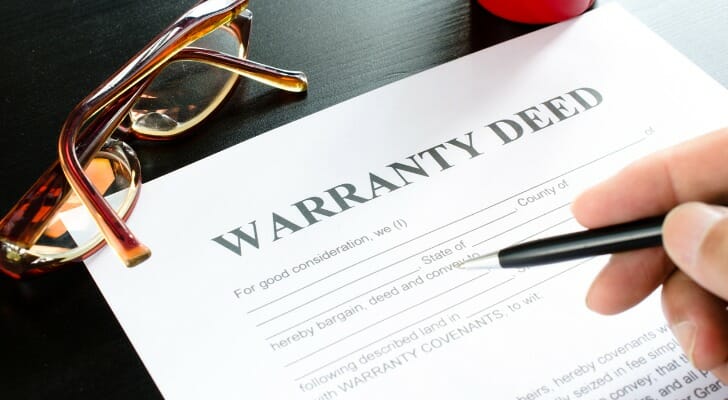A warranty deed, as its name suggests, comes with warranties. The person or persons transferring the property, whether it’s being bought as a residence or as an investment guarantee they own it and have the authority to transfer any rights to it that are enclosed in the deed. A quitclaim deed is both more and less comprehensive. It makes no guarantees about the party or parties transferring the property. Instead, it simply says that they give you any and all rights they have in the underlying property, whatever those rights may be.
Consider working with a financial advisor when buying or selling real estate assets.
How Deeds Work
A deed is a legal instrument that grants you ownership over a piece of real estate. This legal document contains the full description of the property you are receiving and any specific rights that you will or will not receive. The person transferring property rights is called the grantor, while the person who receives those property rights is called the grantee.
Deeds typically contain several essential pieces of information. The most crucial include:
- Title: This covers who owns the title and if ownership is divided among more than one party.
- Rights: This details whether you own the property completely (known among lawyers as “ownership in fee simple”), or whether other parties have certain rights to the property.
- Description: This is how the property is defined.
A deed must exist in writing as all jurisdictions require a written record for real estate transfers. It must specify the property being transferred, the owner’s specific intent to transfer that property and the person who is receiving it.
It is important to note that a deed is not a contract. A contract is an agreement between two parties for each to take some action on the other’s behalf. (I give you $5, you give me a fancy coffee.) Instead a deed is the action. It is the document which transfers the property described within. In a real estate transaction, the parties outline their terms of sale in one document (the contract). Then the property owner conveys that property in a separate document (the deed).
Modern deeds will often use standardized property descriptions to define the property being transferred, typically referring to public records and plat divisions. Older deeds, however, will use a wider variety of descriptions. They may use measurements to describe a property, refer to historic records and often base a property description on landmarks. This can cause significant confusion when trying to define the boundaries of a modern piece of land, as historic deeds may refer to landmarks the no longer exist or documents that have been lost.
This is one of the reasons why lawyers will use two main documents when it comes to property transfer: the quitclaim deed and the warranty deed.
What Is a Quitclaim Deed?
A quitclaim deed is the most basic form of deed. In it, the grantor transfers absolutely any and all rights they have in the property to the grantee. As its name suggests, they are now quit of any claim on the property.
The benefit to a quitclaim deed is finality. The grantor cannot assert any future claim over the property, while the grantee has received any and all title that the grantor once held. A quitclaim deed is also structurally simple. In a very real sense you could write one on a cocktail napkin. It says nothing other than:
- This is the property.
- I, the grantor, transfer all of my rights and title to the property.
- You, the grantee, receive all of my rights and title to the property.
This structure makes a quitclaim deed popular for transfers where property rights may be old, contested or otherwise uncertain. It ensures that whatever rights the grantor had, they now belong to the grantee. However, a quitclaim deed does not certify what the rights of the grantor actually are. You get what the grantor has. If they own the property outright, you get outright ownership of the property. If they have no legitimate claim at all, you get nothing.
This is particularly complicated given the many ways ownership of land can split up over time. If the grantor doesn’t own the land, shares ownership with someone else, or has partial rights to the property, the land will come with those restrictions attached. Regardless of the outcome, the grantee cannot sue under a quitclaim deed.
This is the core problem with a quitclaim deed. If you don’t get the property rights that you expected, you don’t have a cause of action against the grantor. You can’t get your money back or have any other form of recovery.
The legal system handles this problem in several ways. Often, this is resolved in the sales contract for a piece of land. The seller will detail the scope of their ownership in the property, so if the buyer receives anything less they can sue under that contract. It is common for property sales to use a quitclaim deed and protect the buyer through contract law. However, another way to handle this is with a warranty deed.
What Is a Warranty Deed?

A warranty deed is part contract, part conveyance. Like all deeds, a warranty deed transfers ownership of property from one person to another. This includes a description of the transferring property, as well as the rights which the grantor holds on that property.
However, a warranty deed takes an extra step. This document also guarantees (or “warranties”) the nature of the grantor’s rights to the land. In most deals this means that the warranty deed certifies that the grantor owns the property outright, in “fee simple,” and that no other parties have a claim on it. This includes a guarantee that no one else has an ownership stake, that there are no liens or other debt burdens and that no third parties have access rights. If any third-party claims exist, the warranty deed details them.
In a warranty deed, the grantor takes legal responsibility for the title to the land. They are effectively saying, “I promise that I own this land, and those ownership rights are now yours.” This gives the grantee a cause of action if some third party does come along with an unexpected claim.
This cause of action is the essential difference between a warranty deed and a quitclaim.
Warranty Deed vs. Quitclaim Deed
The most important difference between a warranty deed and a quitclaim deed is that a warranty deed lets you sue the grantor if something goes wrong. A quitclaim deed gives you no cause of action against the grantor if they don’t give you the property rights you expected. In modern real estate transactions this distinction has eroded considerably.
The important thing to remember is that no deed can fix a defective title. If someone sells you land that they don’t own, there’s nothing you can do to get that title from them. Instead, the main question is how you to get your money back.
With a warranty deed, you have an inherent right to sue the grantor. They promised you in the deed itself that they had title and, as a result, you can sue on that basis alone. With a quitclaim deed, you have no inherent right to sue. The deed made no promises about the grantor’s title, just that they were giving you whatever they had. Instead, virtually all modern real estate transactions come with a contract to sell the land. This contract specifies what the grantor is selling, including the scope of their title. As the buyer, if the seller gave you a quitclaim deed to property they didn’t own, you would sue under the contract for sale.
In most transactions this has reduced, if not outright eliminated, the functional difference between quitclaim and warranty deeds.
Bottom Line

A quitclaim deed transfers all of someone’s rights in the underlying property, but makes no assurances about what those rights are. If they own the property outright, the quitclaim deed transfers full ownership. If they don’t own the property at all, the quitclaim deed doesn’t transfer anything.
A warranty deed transfers someone’s rights in the underlying property. It also promises that the person transferring this property actually owns it. If they transfer rights that they don’t have, the warranty deed gives you a cause of action against them.
Tips on Buying and Selling Real Estate
- Ready to buy your first home? Thinking of selling? Consult a financial advisor to ensure you are handling things in the best possible way. Finding a qualified financial advisor doesn’t have to be hard. SmartAsset’s free tool matches you with up to three financial advisors who serve your area, and you can interview your advisor matches at no cost to decide which one is right for you. If you’re ready to find an advisor who can help you achieve your financial goals, get started now.
- The mortgage rate environment is more volatile now than ever. Check out SmartAsset’s mortgage rates table to get a better idea of what the market looks like right now.
- Your mortgage debt can play a significant role in the way you plan retirement. That’s why one of your most useful tools is a free mortgage calculator.
Photo credit: ©iStock.com/fizkes, ©iStock.com/maybefalse, ©iStock.com/Dilok Klaisataporn
